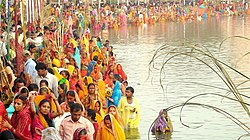Chhath Puja
| Chhath Puja छठ पूजा |
|
|---|---|

Performing of evening & morning Pray to Sun around the holy River
|
|
| Also called | Chhathi Chhath Parv Chhath Puja Dala Chhath Dala Puja Surya Shashthi |
| Observed by |
|
| Liturgical Color | Colors related to Hinduism Saffron (or Bhagwa) |
| Type | Cultural, Historical, Religious |
| Significance | To thank Sun for bestowing the bounties of life on earth and fulfilling particular wishes |
| 2016 date | November 4 to November 7 |
| 2017 date | October 24 to October 27 |
Chhath (Devanagari: छठ, छैठ, छठी, छठ पर्व, छठ पुजा, डाला छठ, डाला पुजा, सूर्य षष्ठी) is an ancient Hindu Vedic festival historically native to eastern Uttar Pradesh and Bihar of India and the Madhesh of Nepal. The Chhath Puja is dedicated to the Sun and his wife Usha in order to thank them for bestowing the bounties of life on earth and to request the granting of certain wishes. This festival is observed by Nepalis and Indian people, along with their diaspora.
The Jeet, considered as the god of energy and of the life-force, is worshiped during the Chhath festival to promote well-being, prosperity and progress. In Hinduism, Sun worship is believed to help cure a variety of diseases, including leprosy, and helps ensure the longevity and prosperity of family members, friends, and elders.
The rituals of the festival are rigorous and are observed over a period of four days. They include holy bathing, fasting and abstaining from drinking water (Barta), standing in water for long periods of time, and offering prashad (prayer offerings) and arghya to the setting and rising sun. Some devotees also perform a prostration march as they head for the river banks.
Environmentalists claim that Chhath is the most eco-friendly Hindu festival. Although the festival is observed most elaborately in Madhesh province of Nepal and Indian states of Bihar, Jharkhand and UP, it is also more prevalent in areas where migrants from those areas have a presence. It is celebrated in all Northern regions and major Northern urban centers in India bordering Nepal. The festival is celebrated in the regions including but not exclusive to the northeast region of India, Madhya Pradesh, Bihar, Uttarkhand, Uttar Pradesh, Chhattisgarh, Jharkhand, RajasthanBangalore,Mauritius, Fiji, South Africa, Trinidad and Tobago, Guyana, Suriname, Jamaica, other parts of the Caribbean, United States, United Kingdom, Republic of Ireland, Australia, New Zealand, Malaysia, Macau, Japan, and Indonesia.
...
Wikipedia
